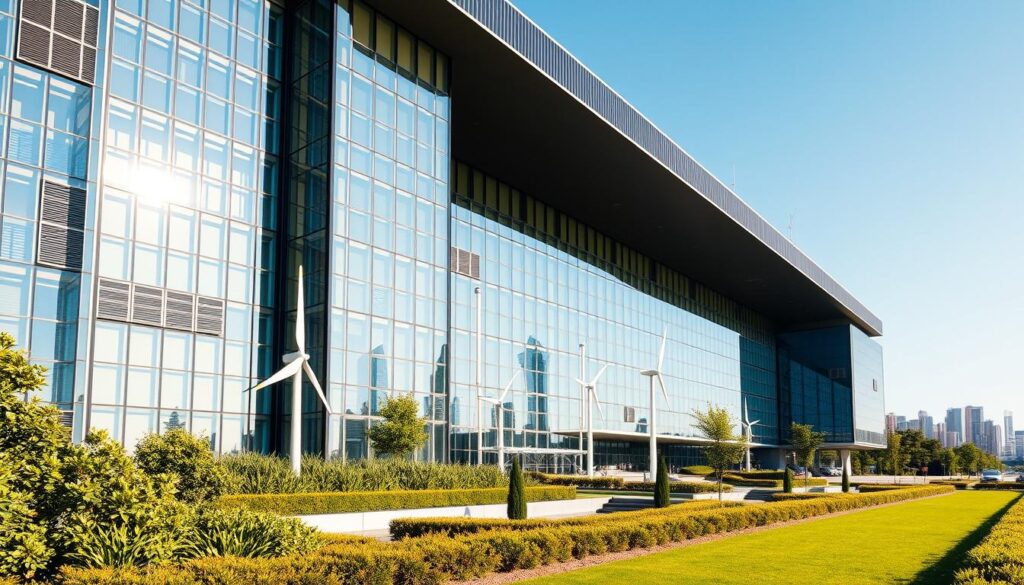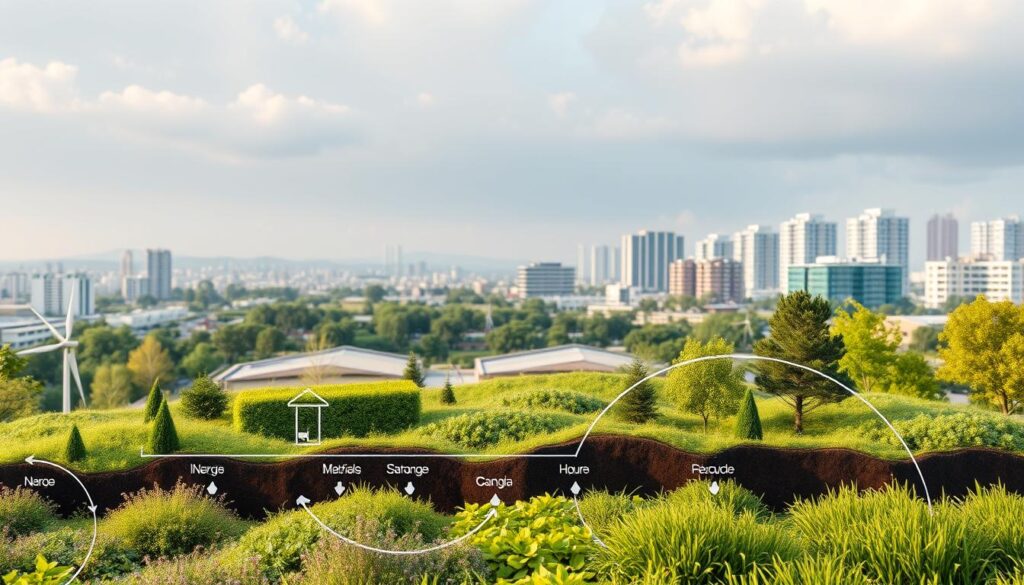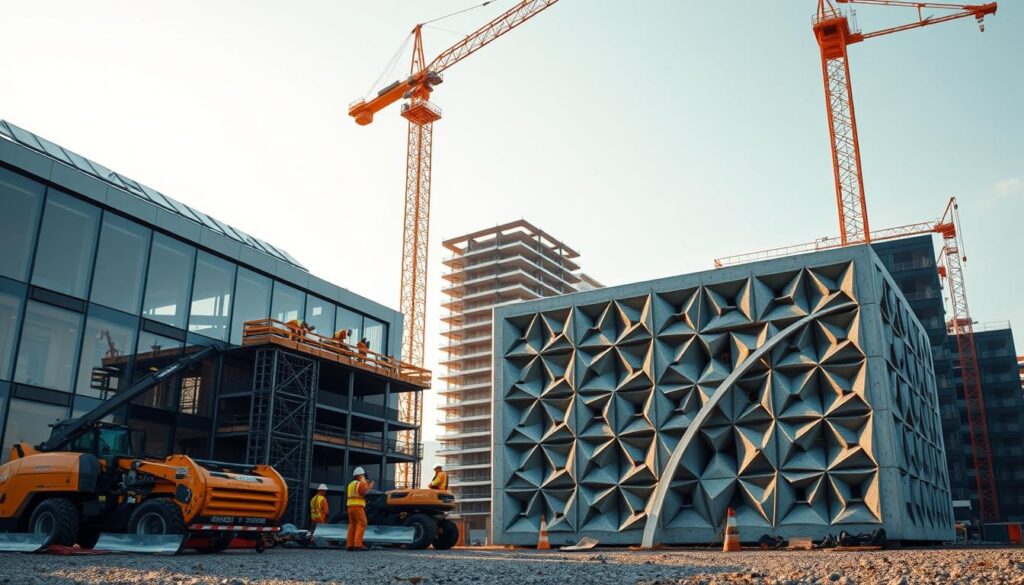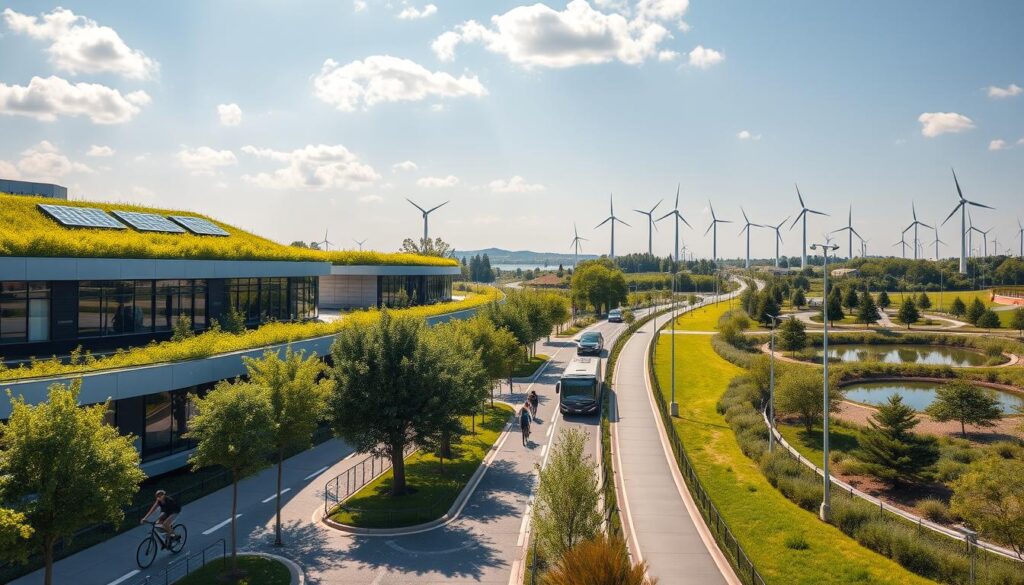The United States is witnessing a significant shift towards eco-friendly infrastructure solutions, driven by the growing awareness of environmental impacts associated with development and construction projects.
As the global community becomes increasingly aware of the need for environmentally responsible infrastructure, civil engineers are playing a crucial role in shaping the future of the built environment in the USA.
The emphasis on sustainable design practices within the field of civil engineering has grown exponentially, transforming the way infrastructure is designed and constructed.
Key Takeaways
- Eco-friendly infrastructure solutions are gaining prominence in the USA.
- Civil engineers are crucial in developing environmentally responsible infrastructure.
- Sustainable design practices are transforming the civil engineering field.
- The shift towards sustainability is driven by growing environmental awareness.
- Eco-friendly infrastructure is becoming a priority in development projects.
Introduction to Sustainable Civil Engineering
In the quest for a more sustainable future, civil engineering plays a pivotal role in shaping eco-friendly infrastructure. Sustainable design in civil engineering involves a holistic approach that balances economic viability, environmental stewardship, and social responsibility.
Importance of Sustainability in Engineering
Sustainability in engineering is crucial as it directly impacts the environment, economy, and society. By adopting sustainable urban planning strategies, engineers can significantly reduce the environmental footprint of infrastructure projects. This includes minimizing waste, using renewable resources, and promoting biodiversity.
Moreover, sustainable practices in civil engineering contribute to the economic viability of projects by reducing long-term costs associated with maintenance and energy consumption. For more information on sustainable building materials, visit World Civil Society.
Overview of Sustainable Practices
Sustainable practices in civil engineering encompass a wide range of techniques and principles. Key among these are energy efficiency, resource conservation, and pollution reduction. Engineers are now focusing on green building initiatives that not only reduce the carbon footprint of buildings but also enhance occupant health and productivity.
An overview of sustainable practices reveals a shift towards innovative materials and technologies that support sustainable development. This includes the use of recycled materials, low-carbon concrete, and advanced renewable energy systems.
Key Principles of Sustainable Design

Civil engineers rely on three core principles to drive sustainable design: minimizing environmental impact, ensuring economic viability, and promoting social equity. These principles are fundamental to creating infrastructure that is not only resilient and efficient but also environmentally conscious and socially responsible.
Environmental Impact Consideration
Minimizing environmental impact is crucial in sustainable design. This involves assessing the potential environmental effects of a project and implementing strategies to mitigate them. Techniques include using environmentally friendly materials, reducing waste, and optimizing energy use. For instance, the use of recycled materials in construction can significantly reduce the demand for virgin resources and lower the carbon footprint of a project.
According to the General Services Administration, sustainable design practices not only reduce environmental impacts but also improve the health and productivity of building occupants.
Economic Viability
Economic viability is another key principle, ensuring that projects are financially sustainable over their lifecycle. This involves considering both the initial costs and the long-term savings or returns on investment. Sustainable infrastructure often requires higher upfront costs but can yield significant savings through reduced energy consumption, lower maintenance costs, and extended lifespan.
| Economic Benefits | Short-Term | Long-Term |
|---|---|---|
| Energy Savings | Minimal | Significant |
| Maintenance Costs | Higher | Lower |
| Lifespan | N/A | Extended |
Social Equity and Community Impact
Promoting social equity and community impact is essential for ensuring that infrastructure projects benefit the local population and enhance their quality of life. This includes designing projects that are accessible, safe, and meet the needs of the community. Engaging with stakeholders and incorporating community feedback into the design process can help achieve these goals.
By integrating these three principles, civil engineers can develop sustainable infrastructure that not only supports economic growth and environmental stewardship but also fosters social equity and community well-being.
Innovative Materials in Civil Engineering
The incorporation of innovative materials is revolutionizing the field of civil engineering, enabling more sustainable practices. The use of such materials is crucial in reducing the environmental footprint of construction projects, which is a significant concern in the USA.
One of the key areas where innovation is making a significant impact is in the development and utilization of materials that are not only sustainable but also enhance the durability and efficiency of infrastructure projects.
Recycled and Upcycled Materials
The use of recycled and upcycled materials is gaining traction in civil engineering. These materials help in reducing waste and conserving natural resources. Examples include:
- Recycled concrete aggregate
- Reclaimed wood
- Recycled metal
These materials not only reduce the need for virgin resources but also decrease the amount of waste sent to landfills.
Low-Carbon Concrete Solutions
Another significant innovation is in the development of low-carbon concrete solutions. Traditional concrete production is a significant source of CO2 emissions, but new technologies are changing this narrative.
Some of the low-carbon concrete solutions include:
- Supplementary cementitious materials (SCMs)
- Recycled concrete aggregate in concrete mixes
- Alternative binders
These innovations are crucial in reducing the carbon footprint of concrete, one of the most widely used materials in construction.
By adopting these innovative materials, civil engineers can significantly contribute to sustainable engineering practices and eco-friendly civil engineering designs, aligning with the global push towards sustainability.
Energy Efficiency in Infrastructure

In the quest for a more sustainable future, enhancing energy efficiency in infrastructure is paramount. As cities grow and develop, the need for sustainable construction techniques becomes increasingly important. Energy efficiency is not just about reducing energy consumption; it’s also about promoting green building initiatives that benefit both the environment and the community.
Role of Renewable Energy Sources
Renewable energy sources play a crucial role in achieving energy efficiency in infrastructure. By harnessing energy from sources like solar, wind, and hydroelectric power, civil engineers can significantly reduce the reliance on fossil fuels. This not only decreases greenhouse gas emissions but also helps in creating a more sustainable energy mix. For instance, incorporating solar panels into building designs can provide a clean source of energy.
For more information on emerging trends in green building, visit World Civil Society.
Designing for Energy Performance
Designing for energy performance is another key strategy in enhancing energy efficiency. This involves using advanced technologies and materials to minimize energy loss and optimize energy use. Techniques such as using high-performance insulation and energy-efficient windows can significantly reduce the energy required for heating and cooling buildings.
- Optimizing building orientation to maximize natural light and heat
- Using energy-efficient HVAC systems
- Incorporating smart building technologies to monitor and manage energy use
By focusing on these strategies, civil engineers can create infrastructure that is not only sustainable but also cost-effective in the long run. As the field continues to evolve, the integration of sustainable construction techniques and innovative design practices will be crucial in shaping a more energy-efficient future.
Water Resource Management
The importance of water resource management cannot be overstated, especially when it comes to sustainable civil engineering practices. Effective water resource management is essential for conserving water and reducing the environmental impact of infrastructure projects.
Two critical aspects of water resource management are stormwater management techniques and sustainable irrigation solutions. Stormwater management involves strategies to handle rainwater runoff, reducing the risk of flooding and improving water quality. Techniques such as permeable pavements, green roofs, and rain gardens are becoming increasingly popular in urban areas.
Stormwater Management Techniques
Stormwater management techniques are designed to mitigate the effects of urbanization on water cycles. By implementing measures such as detention ponds and bioswales, cities can reduce stormwater runoff and improve water quality. According to a study on urban water management, such techniques can significantly reduce the burden on urban drainage systems effective urban water management strategies.
Sustainable Irrigation Solutions
Sustainable irrigation solutions are crucial for reducing water waste in agricultural and landscaping projects. Techniques such as drip irrigation and the use of drought-resistant plants can significantly reduce water consumption. Moreover, the use of smart irrigation systems that adjust watering schedules based on weather conditions can further enhance water efficiency.
By incorporating these strategies into civil engineering projects, it’s possible to achieve significant water savings and reduce the environmental footprint of infrastructure development. As the world continues to urbanize, the importance of effective water resource management will only continue to grow, making it a key area of focus for sustainable urban planning strategies.
Sustainable Transportation Solutions

Sustainable transportation is no longer a choice but a necessity for a sustainable future, and innovative solutions are emerging. The transportation sector is one of the largest contributors to greenhouse gas emissions, making it imperative to adopt sustainable infrastructure development practices.
One of the key areas of focus is the use of green road materials. Traditional road construction materials have significant environmental impacts, from extraction to disposal. However, innovative materials such as recycled asphalt, warm-mix asphalt, and permeable pavers are being increasingly used to reduce these impacts.
Green Road Materials
Green road materials not only reduce the environmental footprint of road construction but also offer improved durability and performance. For instance, warm-mix asphalt is produced at lower temperatures than traditional hot-mix asphalt, reducing energy consumption and emissions.
| Material | Environmental Benefit | Performance Benefit |
|---|---|---|
| Recycled Asphalt | Reduces waste and conserves natural resources | Equivalent performance to new asphalt |
| Warm-Mix Asphalt | Lower production temperature reduces emissions | Improved workability and compaction |
| Permeable Pavers | Reduces stormwater runoff and filters pollutants | Durable and aesthetically pleasing |
Public Transit Innovations
In addition to green road materials, public transit innovations are crucial for sustainable transportation. Efficient public transit systems can significantly reduce the number of private vehicles on the road, thereby decreasing emissions and congestion. For more information on how civil engineering is shaping the built environment, visit World Civil Society.
Some of the innovations in public transit include the adoption of electric and hybrid buses, improved route optimization, and the integration of transit systems with other modes of transportation, such as cycling and walking infrastructure.
By embracing these sustainable transportation solutions, cities can create a more environmentally friendly, efficient, and equitable transportation system. As the world continues to urbanize, the importance of sustainable transportation will only continue to grow.
Land Use Planning and Sustainable Development
Land use planning plays a pivotal role in shaping sustainable communities by promoting eco-friendly practices and reducing urban sprawl. Effective land use planning is essential for balancing economic growth, environmental stewardship, and social equity.
Principles of Smart Growth
Smart growth is an urban planning approach that promotes compact, walkable, and mixed-use development. It encourages the efficient use of land, reduces the need for lengthy commutes, and fosters vibrant, livable communities.
- Compact Development: Encourages dense, walkable neighborhoods that reduce the need for sprawl.
- Mixed-Use Development: Combines residential, commercial, and recreational spaces, enhancing community interaction.
- Public Transportation: Invests in efficient public transit systems to reduce reliance on personal vehicles.
For more information on how civil engineers can impact urban planning, visit Pape-Dawson’s insights on land use and.
Minimizing Urban Sprawl
Urban sprawl is a significant challenge in sustainable development, leading to increased infrastructure costs, traffic congestion, and environmental degradation. Strategies to minimize sprawl include:
- Infill Development: Focuses on developing vacant or underutilized parcels within existing urban areas.
- Green Belts: Establishes protected areas around cities to limit outward expansion and preserve natural habitats.
- Transit-Oriented Development (TOD): Concentrates development around public transportation hubs, reducing the need for personal vehicles.
By adopting these strategies, communities can promote eco-friendly civil engineering designs that support sustainable urban planning and reduce the environmental footprint of development projects.
Lifecycle Assessment in Engineering Projects

Sustainable engineering practices hinge on lifecycle assessment, a methodology that evaluates the environmental and economic impacts of projects throughout their entire lifespan. This approach is crucial for ensuring that infrastructure is designed to last, reducing the need for frequent repairs or replacements.
Understanding Lifecycle Costs
Understanding lifecycle costs is a critical aspect of lifecycle assessment. It involves analyzing all the costs associated with a project, from initial investment to maintenance and eventual decommissioning. By doing so, engineers can identify the most cost-effective solutions that also meet sustainability criteria.
For instance, a study on highway construction found that using durable materials might increase initial costs but significantly reduce maintenance expenses over the project’s lifespan. This is illustrated in the following table:
| Material | Initial Cost | Maintenance Cost (20 years) | Total Lifecycle Cost |
|---|---|---|---|
| Standard Asphalt | $100,000 | $50,000 | $150,000 |
| Durable Concrete | $150,000 | $10,000 | $160,000 |
Importance of Material Durability
Material durability plays a significant role in the lifecycle assessment of engineering projects. Durable materials can withstand environmental stresses, reducing the need for repairs and replacements. As
“The choice of material can significantly impact the lifecycle cost and environmental footprint of a project.”
, emphasizes the importance of selecting the right materials.
By focusing on lifecycle assessment and material durability, engineers can develop infrastructure that is not only sustainable but also economically viable in the long term. This approach supports the adoption of sustainable construction techniques that minimize environmental impact while maximizing economic benefits.
Green Building Certifications
Green building certifications are setting a new standard for the construction industry, focusing on sustainability and reduced environmental impact. These certifications provide a framework for assessing the environmental performance of buildings and encourage the adoption of sustainable practices throughout the construction process.
One of the most recognized green building certifications is LEED (Leadership in Energy and Environmental Design). Developed by the U.S. Green Building Council, LEED provides a comprehensive framework for identifying and implementing practical and measurable green building design, construction, operations, and maintenance solutions.
LEED Certification Overview
LEED certification is awarded based on a point system, with projects earning points for various sustainable design and construction elements. The categories include Sustainable Sites, Water Efficiency, Energy and Atmosphere, Materials and Resources, Indoor Environmental Quality, and Innovation in Design. Projects can achieve four levels of certification: Certified, Silver, Gold, and Platinum, based on the number of points earned.
For instance, a project that incorporates renewable energy systems, rainwater harvesting, and recycled materials can earn significant points towards LEED certification. The integration of sustainable practices not only contributes to environmental conservation but also enhances the project’s marketability and value.
Other Notable Green Certifications
Apart from LEED, there are other notable green building certifications that promote eco-friendly infrastructure solutions. These include:
- WELL Building Standard, which focuses on the health and well-being of building occupants.
- Passive House, a rigorous standard for energy efficiency.
- Green Globes, a certification that assesses the environmental performance of buildings.
The following table provides a comparison of these certifications:
| Certification | Focus Area | Certification Levels |
|---|---|---|
| LEED | Sustainability and Environmental Performance | Certified, Silver, Gold, Platinum |
| WELL Building Standard | Health and Well-being of Occupants | Silver, Gold, Platinum |
| Passive House | Energy Efficiency | Classic, Plus, Premium |
| Green Globes | Environmental Performance | 1-4 Globes |
In conclusion, green building certifications like LEED and others play a crucial role in promoting sustainable construction practices. By adopting these certifications, builders and developers can contribute to a more environmentally responsible construction industry.
Role of Technology in Sustainable Practices

The integration of technology in civil engineering has revolutionized sustainable practices, enabling more efficient and environmentally friendly construction processes. Technology has become a cornerstone in the pursuit of sustainability, offering innovative solutions to longstanding challenges.
Building Information Modeling (BIM)
Building Information Modeling (BIM) is a digital representation of the physical and functional characteristics of a building. BIM technology allows for the creation of detailed 3D models that can be used throughout the construction process, from design to completion. This technology enhances collaboration among stakeholders, reduces errors, and improves project outcomes.
By utilizing BIM, construction teams can simulate various scenarios, predict potential issues, and optimize the building’s performance. This leads to more sustainable construction techniques being implemented, as potential environmental impacts can be assessed and mitigated early in the project.
Drones and Data Collection
Drones have emerged as a valuable tool in construction, providing real-time data and insights that can significantly enhance project efficiency. Equipped with high-resolution cameras and sensors, drones can capture detailed images and data on construction sites, allowing for accurate monitoring of progress and site conditions.
The use of drones in construction also supports sustainable engineering practices by enabling the early detection of potential environmental issues, such as soil erosion or water accumulation. This proactive approach helps in minimizing the environmental footprint of construction projects.
For more insights on how technology is transforming civil engineering, visit World Civil Society to explore the impact of AI in the field.
Community Engagement in Design Processes
Effective community engagement is crucial for the success of infrastructure projects, ensuring they meet the needs and expectations of the community. By involving stakeholders early and often, engineers can create designs that are not only eco-friendly but also align with sustainable urban planning strategies.
Community engagement is a multifaceted process that involves understanding the needs, concerns, and aspirations of the community. It requires a proactive approach, where engineers and designers work closely with stakeholders to gather input and feedback.
Stakeholder Input
Stakeholder input is a critical component of community engagement. It involves identifying and involving individuals and groups who will be impacted by the project. This can include local residents, business owners, community groups, and government agencies.
By engaging with stakeholders, engineers can gain valuable insights into the community’s needs and preferences. This information can be used to inform design decisions, ensuring that the final product is acceptable to the community and meets their needs.
| Benefits of Stakeholder Input | Description |
|---|---|
| Increased Community Acceptance | Projects are more likely to be accepted by the community when they are involved in the design process. |
| Better Design Outcomes | Stakeholder input can lead to more innovative and effective design solutions. |
| Reduced Project Risks | Engaging with stakeholders can help identify and mitigate potential risks and issues early on. |
Building Trust with Communities
Building trust with communities is essential for successful community engagement. It involves being transparent, responsive, and inclusive in the design process.
Trust can be fostered by maintaining open lines of communication, providing clear and timely information, and demonstrating a commitment to addressing community concerns.
By prioritizing community engagement and stakeholder input, engineers can create infrastructure projects that are not only sustainable and eco-friendly but also meet the needs and expectations of the community. This approach contributes to the overall success of the project and enhances the quality of life for community members.
Case Studies of Successful Projects

Successful sustainable projects demonstrate the potential for environmentally friendly construction methods to redefine urban landscapes. By examining real-world examples, we can gain a deeper understanding of the strategies and practices that contribute to successful sustainable infrastructure development.
Examples of Sustainable Infrastructure
Numerous case studies highlight the effectiveness of sustainable infrastructure projects. For instance, the use of recycled materials in construction has been shown to reduce waste and lower project costs. Additionally, case studies from leading institutions provide valuable insights into innovative sustainable practices.
One notable example is the implementation of green roofs in urban areas, which not only reduce energy consumption but also create habitats for local wildlife. Such projects demonstrate the multifaceted benefits of sustainable infrastructure development.
Lessons Learned from the Field
Through the analysis of successful projects, several key lessons emerge. Firstly, the importance of community engagement cannot be overstated. Projects that involve local stakeholders from the outset tend to have greater acceptance and success.
“Sustainable development is not just about technology; it’s about people and the planet.” – This quote highlights the human and environmental aspects of sustainable infrastructure development.
Furthermore, the use of environmentally conscious construction methods is crucial. Techniques such as modular construction and the use of low-carbon concrete can significantly reduce the environmental impact of infrastructure projects.
By learning from these case studies, professionals in the field can apply these insights to future projects, driving further innovation in sustainable infrastructure development.
Future Trends in Sustainable Civil Engineering
The future of sustainable civil engineering is being shaped by emerging technologies and regulatory changes. As the industry continues to evolve, professionals must stay ahead of these trends to deliver sustainable infrastructure that meets the needs of a growing population.
Advancements in Technology
New sustainable technologies are being developed to reduce environmental impact. Innovations in materials science, such as advanced recycled materials and low-carbon concrete solutions, are being integrated into sustainable engineering practices. These advancements are crucial for green building initiatives and will continue to play a significant role in shaping the industry.
Evolving Regulatory Landscape
Regulatory changes are also driving the adoption of sustainable practices. Governments are implementing policies that encourage the use of green technologies and sustainable materials. As these regulations evolve, civil engineers must adapt to ensure compliance and continue to deliver projects that meet the highest standards of sustainability.
By embracing emerging technologies and staying informed about regulatory changes, the civil engineering industry can continue to advance sustainable engineering practices and green building initiatives, creating a more sustainable future for generations to come.
